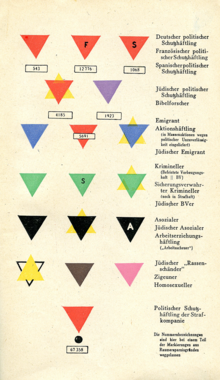Our website is made possible by displaying online advertisements to our visitors.
Please consider supporting us by disabling your ad blocker.
Nazi concentration camp badge

Nazi concentration camp badges, primarily triangles, were part of the system of identification in German camps. They were used in the concentration camps in the German-occupied countries to identify the reason the prisoners had been placed there.[1] The triangles were made of fabric and were sewn on jackets and trousers of the prisoners. These mandatory badges of shame had specific meanings indicated by their colour and shape. Such emblems helped guards assign tasks to the detainees. For example, a guard at a glance could see if someone was a convicted criminal (green patch) and thus likely of a tough temperament suitable for kapo duty.
Someone with an escape suspect mark usually would not be assigned to work squads operating outside the camp fence. Someone wearing an F could be called upon to help translate guards' spoken instructions to a trainload of new arrivals from France. Some historical monuments quote the badge-imagery, with the use of a triangle being a sort of visual shorthand to symbolize all camp victims.
The modern-day use of a pink triangle emblem to symbolize gay rights is a response to the camp identification patches.
- ^ "The History Place – Holocaust Timeline: Nazis Open Dachau Concentration Camp". historyplace.com. Retrieved 27 March 2018.
Previous Page Next Page
شارة معسكر الاعتقال النازي Arabic KZ-Winkel German Koonduslaagrite vangide eraldustunnused ET Système des badges des camps de concentration nazis French Distintivo dos campos de concentración nazis GL Lencana kamp konsentrasi Nazi ID Winkiel (gwara obozowa) Polish Emblemas de campo de concentração nazista Portuguese Nazi concentration camp badge SIMPLE 納粹集中營臂章 Chinese


